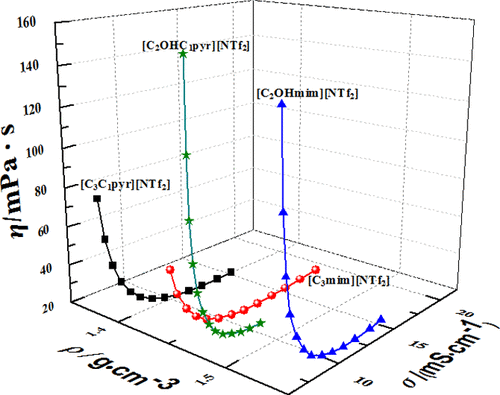当前位置:
X-MOL 学术
›
J. Chem. Eng. Data
›
论文详情
Our official English website, www.x-mol.net, welcomes your
feedback! (Note: you will need to create a separate account there.)
Hydroxyethyl Group Effect on Properties of Bis[(trifluoromethyl)sulfonyl]imide-Type Ionic Liquids
Journal of Chemical & Engineering Data ( IF 2.0 ) Pub Date : 2020-09-08 , DOI: 10.1021/acs.jced.0c00187 Qingshan Liu 1 , Liwei Zhao 2 , Liansheng Ma 2 , Jiamin Chu 1 , Jian Wang 3 , Ying Zang 4
Journal of Chemical & Engineering Data ( IF 2.0 ) Pub Date : 2020-09-08 , DOI: 10.1021/acs.jced.0c00187 Qingshan Liu 1 , Liwei Zhao 2 , Liansheng Ma 2 , Jiamin Chu 1 , Jian Wang 3 , Ying Zang 4
Affiliation

|
1-Propyl-3-methylimidazolium bis[(trifluoromethyl)sulfonyl]imide ([C3mim][NTf2]), 1-propyl-1-methylpyrrolidinium bis[(trifluoromethyl)sulfonyl]imide ([C3C1pyr][NTf2]), 1-hydroxyethyl-3-methylimidazolium bis[(trifluoromethyl)sulfonyl]imide ([C2OHmim][NTf2]), and N-hydroxyethyl-N-methylpyrrolidinium bis[(trifluoromethyl)sulfonyl]imide ([C2OHC1pyr][NTf2]) hydrophobic ionic liquids (ILs) were synthesized. The basic properties including density, dynamic viscosity, electrical conductivity, refractive index, decomposition temperature, and molar heat capacity of the four pure ILs were determined by traditional methods. The basic properties of the hydroxyethyl-type functional ionic liquids (FILs) were also compared with the common ILs and other type FILs. According to the linear equation, the density and refractive index were discussed. The data of electrical conductivity and dynamic viscosity were processed by the Vogel–Fulcher–Tamman and Arrhenius equations, and the activation energies of dynamic viscosity and electrical conductivity were obtained by both above-mentioned equations. The Walden rule was used for describing the relationship of density, dynamic viscosity, and electrical conductivity for ILs. The decomposition temperature and molar heat capacity were also determined and discussed in the studied temperature range.
中文翻译:

羟乙基对双[(三氟甲基)磺酰基]酰亚胺型离子液体性能的影响
1-丙基-3-甲基咪唑鎓双[(三氟甲基)磺酰基]酰亚胺([C 3 mim] [NTf 2 ]),1-丙基-1-甲基吡咯烷鎓双[(三氟甲基)磺酰基]酰亚胺([C 3 C 1 pyr] [NTf 2 ]),1-羟乙基-3-甲基咪唑鎓双[(三氟甲基)磺酰基]酰亚胺([C 2 OHmim] [NTf 2 ])和N-羟乙基-N-甲基吡咯烷鎓双[(三氟甲基)磺酰基]酰亚胺( [C 2 OHC 1吡咯] [NTf 2])合成了疏水离子液体(ILs)。通过传统方法确定了四个纯IL的基本性质,包括密度,动态粘度,电导率,折射率,分解温度和摩尔热容。还将羟乙基型功能性离子液体(FIL)的基本特性与常见的IL和其他类型的FIL进行了比较。根据线性方程,讨论了密度和折射率。用Vogel-Fulcher-Tamman和Arrhenius方程处理电导率和动态粘度的数据,并通过上述两个方程式获得动态粘度和电导率的活化能。Walden规则用于描述密度,动态粘度,IL的电导率。还确定了分解温度和摩尔热容,并在研究的温度范围内进行了讨论。
更新日期:2020-10-08
中文翻译:

羟乙基对双[(三氟甲基)磺酰基]酰亚胺型离子液体性能的影响
1-丙基-3-甲基咪唑鎓双[(三氟甲基)磺酰基]酰亚胺([C 3 mim] [NTf 2 ]),1-丙基-1-甲基吡咯烷鎓双[(三氟甲基)磺酰基]酰亚胺([C 3 C 1 pyr] [NTf 2 ]),1-羟乙基-3-甲基咪唑鎓双[(三氟甲基)磺酰基]酰亚胺([C 2 OHmim] [NTf 2 ])和N-羟乙基-N-甲基吡咯烷鎓双[(三氟甲基)磺酰基]酰亚胺( [C 2 OHC 1吡咯] [NTf 2])合成了疏水离子液体(ILs)。通过传统方法确定了四个纯IL的基本性质,包括密度,动态粘度,电导率,折射率,分解温度和摩尔热容。还将羟乙基型功能性离子液体(FIL)的基本特性与常见的IL和其他类型的FIL进行了比较。根据线性方程,讨论了密度和折射率。用Vogel-Fulcher-Tamman和Arrhenius方程处理电导率和动态粘度的数据,并通过上述两个方程式获得动态粘度和电导率的活化能。Walden规则用于描述密度,动态粘度,IL的电导率。还确定了分解温度和摩尔热容,并在研究的温度范围内进行了讨论。









































 京公网安备 11010802027423号
京公网安备 11010802027423号